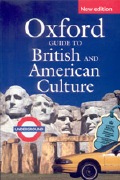
March 2006
Volume 9, Number 4
| Contents | | | TESL-EJ Top |
 |
March 2006
|
||
|
Oxford Guide to British and American Culture (New Edition) | |||
| Author: | Jonathan Crowther (2005) |  | |
| Publisher: | Oxford: Oxford University Press | ||
| Pages | ISBN | Price | |
|---|---|---|---|
| Pp. viii + 534 | 019-4311295 (paper) | £16.95 | |
Culture encompasses all the activities of a given society. It includes art, folklore, customs, beliefs, and other products of human thought. It may be difficult for individuals from one culture to understand and appreciate the ways of thinking and products of another culture, especially if the other culture is very different from the one that the individual grew up in; but the task can be made easier if the learner has tools that can facilitate the process. The Oxford Guide to British and American Culture (New Edition) is just such a tool.
This book offers learners of English as a Second Language the most up-to-date guide to contemporary British and American culture. It is recommended for upper-intermediate to advanced learners of English; however, it can be used to some extent at other levels. It can also be a valuable source of information for those who are not enrolled in a language-learning program but would like to become familiar with British or American culture. Additionally, language teachers might find this guide an excellent source of supplementary material.
The Oxford Guide to British and American Culture provides insights into what is important or popular in present-day Britain and America in an engaging manner, focusing on the practical applications of such information. Thus, the book is a handy guide for those who are interested in exploring the "real-world" environment of these two major countries.
The information in the Guide is organized under various headings arranged in alphabetical order, like a dictionary. It consists of 10,000 entries. In addition, there are hundreds of illustrations, including color photographs and maps, to help the learner get a visual sense of what he or she is reading about. The abbreviations, symbols, and labels used in the guide are explained in the beginning of the text. Such useful features make accessing the material convenient and allow the reader to use the Guide as one would use other reference books.
This Guide is an excellent source of supplementary material for the ESL teacher in the language classroom since it can be applied effectively to the teaching of all four language skills: reading, writing, speaking, and listening. In teaching reading skills, the Guide can be used to provide students with practice in scanning for specific information. In teaching writing skills, the teacher can use information from the Guide, such as that on American and British breakfasts, as a springboard for writing comparisons-in this case, comparing American and British breakfasts with breakfast in the learner's home country. This exercise could be adapted to speaking and listening, with learners being asked to do a presentation on breakfast in their home country, or to participate in a classroom discussion about the relative health benefits of different kinds of breakfasts.
The Guide allows learners to (1) discover facts and figures about Britain and America in the 21st century (e.g., "Timeline of Britain History," p. C4-5 or "Timeline of US History," p. C18-19); (2) explore the lives of the rich, the famous and the infamous, history, legends, festivals, music, food, shopping, and attitudes (e.g., "muffin," p. 313; "Radiohead," p. 389); (3) look up famous quotations and sayings and find out who said what (e.g., "Just do it," Nike advertising slogan under "Nike&trade:," p. 323); and (4) get ideas of what to read-choose from lists of books that won the Booker, Pulitzer and other prizes plus suggestions for further reading (e.g., Winners of the Orange Prize for Fiction under 'the Orange Fiction,' p. 344).
While the Guide is well-organized and thoughtfully put together, its usefulness would have been enhanced by the inclusion of a category (or topic) index, a handy tool which would benefit both instructors and learners. Such an index could be modeled on the "Yellow Pages" of the telephone book, with all the entries containing geographical information, for example, listed together under that topic. Other categories might be people, quotations, books, television series, and so on. Another thing that would have enhanced the value of the Guide is information about certain aspects of other cultures that are considered offensive or come across negatively in American or British culture, for example, certain gestures or mannerisms such as clicking one's fingers to get a waiter's attention in a restaurant. Also, being made aware of interpersonal communication practices, such as the amount of personal space that people in American and British culture expect others to give them, might save learners from other cultures embarrassment in social situations. Information of this nature would have added to the book's real, practical value to students from the increasingly broad range of cultures in our classrooms.
Overall, I find the Oxford Guide to British and American Culture an excellent reference book for learners of English as a Second Language, since it contains informative and practical materials and presents these materials in an effective manner emphasizing ease of use. I strongly recommend this book to both learners and instructors.
Thinan Sangpanasthada
Brock University
<ts98ah brocku.ca>
brocku.ca>
|
© Copyright rests with authors. Please cite TESL-EJ appropriately.
Editor's Note: The HTML version contains no page numbers. Please use the PDF version of this article for citations. |